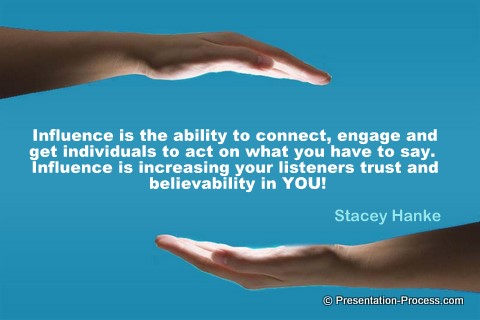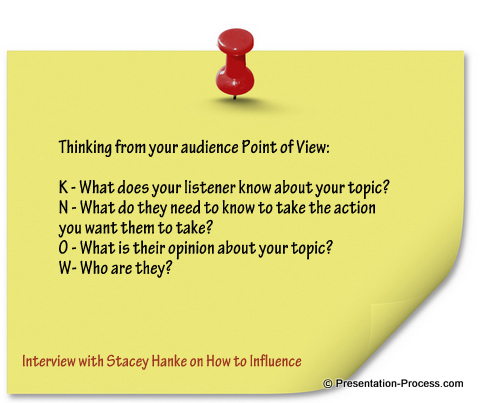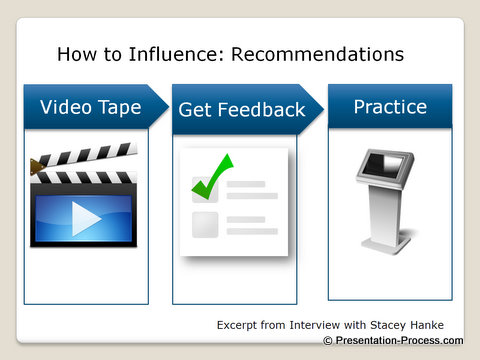Home > How to Present> Interview with Stacey Hanke on How to Influence
 Stacey Hanke is co-author of the book; Yes You Can! Everything You Need From A To Z To Influence Others To Take Action.
Stacey Hanke is co-author of the book; Yes You Can! Everything You Need From A To Z To Influence Others To Take Action.
She founded 1st Impression Consulting, Inc. in 2004. The company focuses on coaching executives and sales professionals how to communicate with impact and influence.
Stacey has been published in various nationwide publications and has also been a guest on numerous national radio shows including WGN Chicago and WLS-AM. She was one of six speakers selected to present at the 2008 NSA Convention in the category “Top Six Under Forty.”
You can find more about her from 1st Impression website and blog.
In this interview with Arte from Presentation-Process, Stacey shares her insights on how to influence your audience when presenting, especially in business situations.
Arte: You work, including your book, focuses a lot on how to influence. Can you tell us little more about why you focus on this specific area?
Stacey: Few individuals know what influence looks and sounds like. Few individuals can define what influence means to them and how to achieve influence.
I work in a variety of industries with Management, Executives and the C-Suite. The majority of these individuals do not receive training in how to communicate effectively or how to influence through their communicate. They believe if they communicate a message their listener hears and understands them. They don’t know what they don’t know. They don’t realize that their non-verbal communication isn’t consistent with their verbal language.
I also focus on how to influence because face-to-face communication is becoming a lost art. Our choices of communication are massive; email, text, twitter, social media, etc. If we don’t use it we lose it!
Arte: What defines having influence? How can presenters measure or evaluate their influence levels?
Stacey: Influence is the ability to connect, engage and get individuals to act on what you have to say. Influence is increasing your listeners trust and believability in YOU! Influence is getting individuals to feel connected with you and wanting to listen and interact with you.

Because we don’t know what we don’t know, you need to 1st take a closer look at how your listeners REALLY see and hear you when you are communicating with them rather than how you feel. Even though you feel comfortable and confident doesn’t guarantee this is how your listeners perceive you!
Learn how to influence better by improving your non-verbal and verbal language;
- Posture
- Movement
- Gestures
- Facial Expressions
- Pause
- Volume
- Inflection
- Verbal Language
- K.N.O.W. your listeners! Your listener will be less forgiving when they know you have not taken the time to get to know them and tailor your message for THEM not you. Use words that will resonate with what is important to your listener.
- Get to the point! Don’t waste your listeners time by telling them too much information and going over the time you were allowed.
- Don’t talk to your visual aids. Stop putting your notes on your visual aids. Your visual aid is to support your message NOT to be your message!!!
- STOP thinking that every time you stand up you’re giving a presentation rather think of it as an enlarged presentation. The more spontaneous you can be the more conversational you will be.
Arte: What is the number 1 mistake you have seen business presenters make that reduces their influence?
Stacey: The number one mistake business presenters make that jeopardizes their ability to influence action; what they say is not consistent with how they say it.
For example, they may be saying how excited they are to offer a new service for their clients – but – their body language and tone of voice communicates they’re nervous, not confident or would rather be someplace else than communicating with this person.
The three communication skills I see individuals are challenged with are;
1. They have eye contact but not eye connection. They scan their audience rather than connect with them. They need to stay connected with one person at a time for a complete sentence or thought. Only speak when you see eyes!
2. They use non-words, ramble and as a result take too long to get to the point.
3. They fidget, their gestures don’t have purpose and their posture doesn’t convey confidence.
Even worse, we don’t realize we are doing these behaviors so we keep using ineffective behaviors, we get the same results, and we are not willing to hold ourselves accountable to do what it takes to make a change and enhance our communication.
Arte: Would like to share a real life example to illustrate this point?
Stacey: I was working with a Sales Executive who was communicating with his sales team the importance of going above and beyond their customer’s needs. As he was expressing this point, he was fidgeting with a pen, using non-words (uh, um, and, so, but, actually), his eyes were darting and he took too long to get to the point.
Arte: It is not very to think from audience point of view. How can presenters develop this habit?
Stacey: Prepare for every conversation thinking about your listeners P.O.V.
The tool I use is the acronym K.N.O.W.
K – What does your listener know about your topic?
N – What do they need to know to take the action you want them to take?
O – What is their opinion about your topic?
W- Who are they?

– What other information do you know about your listener that will help you tailor your message for them?
Use the K.N.O.W. to prepare for your conversation and keep referring to the K.N.O.W. during your conversation to be continuously flexible with weaving the entire experience for them.
Another tool is to begin with the “Why.” Ask yourself “Why does my topic matter to my listener?” “Why are my listeners here to listen to me?” The “Why” is the core to the big picture (the core to your message) and you “Why” needs to be based off of your listeners P.O.V.
Arte: How easy is it for presenters to change the way they communicate? How easy is it to do this without a training intervention?
Stacey: Because changing communication is muscle memory and requires you to change your sub-conscience, it is nearly impossible to make this change in approach to communication on your own.
Here are some recommendations on how to influence better;

– Video tape yourself to see and hear what your listeners see and hear.
– Ask for constructive, balanced feedback. For example, when you ask a peer how you did during your presentation, if they respond, “Good” immediately ask them,
What specifically was good?
What did I do or say that you thought was good?
Without specific feedback, you are not REALLY receiving feedback and you will not improve. Everyone has the opportunity to continuously enhance their communication skills and learn how to influence better. This is a lifelong process. Leaders understand that they are always in school.
– Practice: When you change your communication, practice the skills and techniques in ALL communication skill situations. There is no way you can be an effective presenter (a presenter who has impact and influence) if your day-to-day communication isn’t effective.
Arte: That’s simple and practical advice! Thank you so much for sharing your thoughts and ideas with us!
Stacey: Thank you!
Related: What is your presenter personality type?
Return to Top of Interview with Stacey Hanke on How to Influence Page
